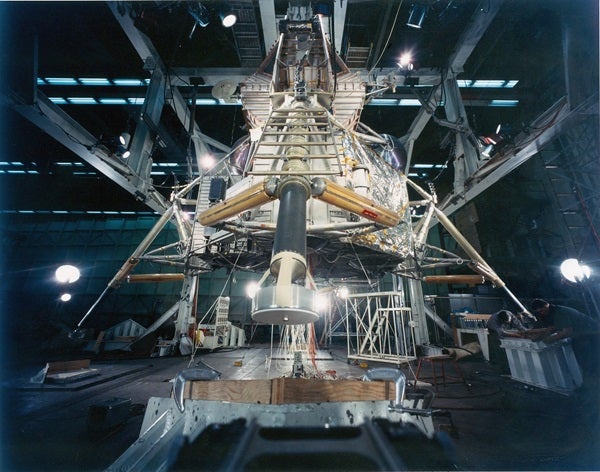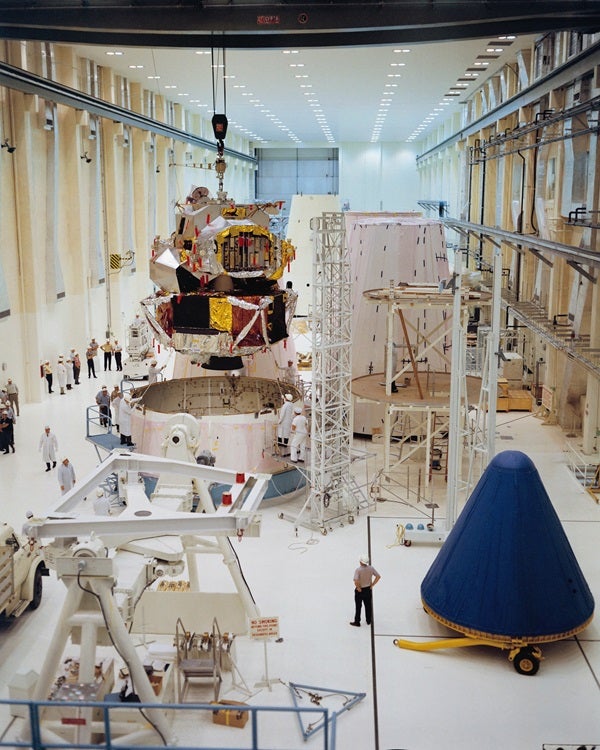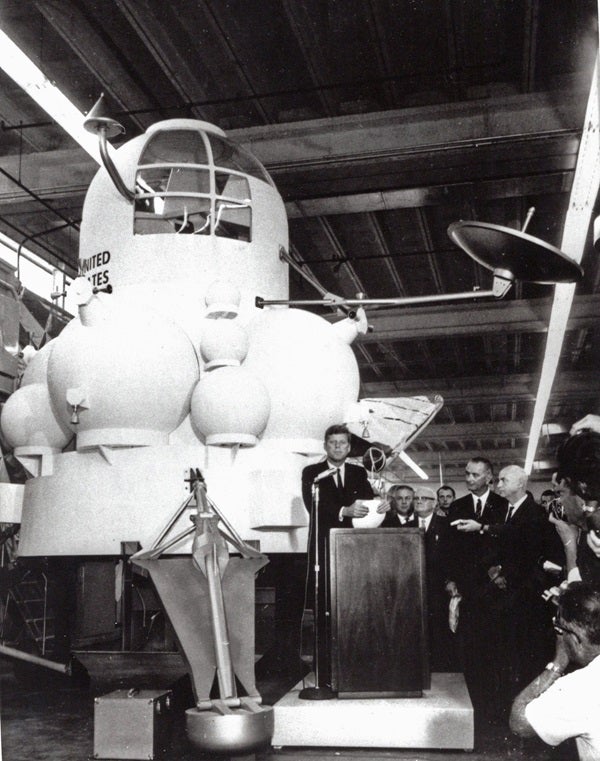His words kicked off arguably the greatest engineering feat in modern history.
Making a Moon ship
The Apollo Command/Service Module (CSM) was conceived as the mothership — the spacecraft that would keep the crew alive throughout the lunar mission all the way to splashdown. The problem was no one knew exactly what that mothership would look like or need to do.
Taking experience from the one-man Mercury program into consideration — NASA had just one suborbital Mercury mission under its belt when Kennedy promised America the Moon — the space agency determined that the Command Module would be a truncated cone with a blunt, rounded bottom. The design was equal parts simplicity and necessity: It was easier to replicate an existing design than start from scratch, and the blunt end protected the crew from the heat generated during atmospheric reentry. It was coupled to the cylindrical Service Module, which carried the consumables (water, oxygen, power) the astronauts needed in space. Only the Command Module would carry the astronauts through reentry; the Service Module would be jettisoned beforehand.
Apollo mission planners believed that the simplest mission profile, or mission mode, was Direct Ascent, in which a craft would go straight to the Moon, land, and return. The entire spacecraft would have to land upright on the Moon; that single spacecraft would also have to carry the propellant necessary to launch from the Moon’s surface and generate enough velocity to return to Earth. Not only was this option complicated, but it involved a heavy payload that would need a massive, not-yet-developed rocket called Nova to get off the ground. An alternate plan involved launching this massive spacecraft in pieces on two smaller Saturn rockets and effectively building it in Earth orbit in a mode called Earth Orbit Rendezvous.
NASA released its first call for proposals July 28, 1961. Interested aerospace companies were asked to present their bids for a three-man spacecraft that could keep astronauts alive in a shirtsleeve environment (i.e., no spacesuit required) for two weeks, with an additional two days of emergency life support in case of an off-target landing. What NASA didn’t ask for at this time was the landing payload; contractors were left to assume that some additional landing stage would turn their cone-shaped mothership into the landing ship. On October 11, 1961, NASA was presented with five bids: three from groups of contractors and two from single companies, one of which was North American Aviation.
North American was the underdog in this race. A month earlier, it had won the bid to build the second stage of the Saturn V rocket, and no one thought it could possibly win a second major piece of Apollo. When NASA reviewed the bids, North American scored second, behind the Martin Company. But North American had unique experience: Not only had it built exceptional planes like the P-51 Mustang and the B-25 bomber, it also had built the rocket-powered X-15 that was breaking speed and altitude records flying to the fringes of space. North American ultimately knew more about the technical and physical stresses of spaceflight than the other contractors, and so it won the contract.
Not one, but two
As North American began building the CSM in early 1962, NASA began considering a new mission mode: Lunar Orbit Rendezvous. This mode kept the CSM and its heavy load of fuel for the return flight in orbit around the Moon, while a dedicated landing vehicle descended to the Moon’s surface. Though the rendezvous made the mission more complicated, it also made the payload lighter, because the lander could be smaller and thus require less fuel to escape the Moon’s gravity. The whole payload would be light enough to launch on a single Saturn V rocket, which was simpler to develop and gave NASA the best chance at meeting Kennedy’s end-of-decade deadline. To the surprise of many within the agency, Lunar Orbit Rendezvous quickly became the favored approach; NASA committed to it July 11.
Suddenly, North American had not only lost the glory of their module landing on the Moon, but the company was also now responsible for modifying its spacecraft to enable docking with the second ship and giving the astronauts some means to travel between the vehicles while they were connected. The required changes were significant; it was almost like building a whole new spacecraft. In an effort to retain its first year of work, North American came up with the “Block” concept. The original spacecraft, which couldn’t support a mission in conjunction with the Lunar Module, was called Block I. The Block II CSM would be designed to support a lunar mission.
The first Block I mission was scheduled as Apollo 1 in early 1967. Owing in large part to the amount of flammable material in the cabin, the pure oxygen environment under high pressure, and the heavy, inward-opening, three-part hatch, when a fire broke out during a routine pre-launch test, the crew had no chance of escape. Virgil “Gus” Grissom, Roger Chaffee, and Ed White were killed on the launchpad January 27, 1967, and for a moment, it looked like the Apollo program might not recover.
The subsequent accident investigation forced NASA to eliminate all Block I manned missions. Block I CSMs flew only on unmanned missions, in some cases with elements of the Block II version added to test them in advance of manned flights. Block II underwent several design changes following the tragedy. Now boasting a safer mixed gas environment on the launchpad as well as a different layout of material inside the spacecraft and a simpler two-part hatch, it made its first flight with Apollo 7 in October 1968.
From that point on, the CSM successfully flew on 10 Apollo missions, six of which landed on the Moon, bringing every astronaut home safely and serving as their home away from home en route to the Moon and back.
How do you land on the Moon?
When NASA began working out the details of how to land on the Moon, the mission involved one spacecraft, not two. But when the agency changed its approach in July 1962, committing instead to Lunar Orbit Rendezvous, a new plan emerged. Now, one astronaut would stay aboard the heavy mothership in lunar orbit, while his two crewmates would descend to the surface.
What they would descend in was unclear. No one knew how to land on another world, much less how to build something that could land on the Moon, so NASA asked interested contractors to submit bids to build the Lunar Excursion Module.
The Grumman Aircraft Engineering Corporation won the contract November 7, 1962. Work officially began January 14, 1963, just a little under seven years to the end-of-decade lunar landing deadline. Things immediately moved quickly, but while North American Aviation attempted to preserve a year’s worth of work with the Block concept, the Lunar Excursion Module suffered through its own development changes.
The first — and simplest — change was the name. NASA decided the word excursion sounded like a school field trip, and so renamed it the Lunar Module (LM). The rest of the spacecraft’s development was much more complicated, right down to the most basic question of how it would be flown.
Grumman engineers merged necessity and experience. Necessity and NASA’s contract specifications dictated the LM would be a two-stage vehicle, wherein the descent stage would land on fixed gear and then serve as a launchpad for the ascent stage. Experience told Grumman that the simplest vertical landing vehicle was a helicopter, so engineers designed the LM with two seats and four bubblelike windows for ample visibility. But those windows caused a huge problem. Not only were they heavy, but they were weak points that opened the LM to potentially fatal temperature fluctuations. To solve this problem, engineers at either NASA or Grumman — recollections are divided — realized that there was no rule saying astronauts had to fly sitting down. Standing closer to smaller windows would give the same visibility and in the Moon’s lower gravity field, just one-sixth what we feel on Earth, human legs would be more-than-adequate shock absorbers for the moment of lunar touchdown.
A buglike craft
By the fall of 1964, after only two years of development, the LM had become a spacecraft designed to do the unimaginable: land on the Moon.
On the outside, it almost didn’t look up to the task. Because it would be launched in a protective shroud and would only fly in a vacuum, Grumman engineers designed the LM from the inside out without worrying about aerodynamics.
Inside the LM, the crew would fly standing up, secured in place by hook-and-loop fasteners on the floor, as well as cables that clipped into their suits at waist level. Around them were 12 instrument panels housing 158 switches, 16 variable controls, four hand controllers, two computer keyboards, and a host of displays. Housed within this hardware was the Primary Guidance and Navigation Section (or PGNS, pronounced “pings”), the onboard digital autopilot system. While the computer monitored the craft’s position, environment, and consumables vital to the landing, the crew could keep an eye on displays and the lunar terrain, taking over manual control if needed. The crew cabin was a snug 92 inches (234 centimeters) in diameter and 42 inches (107 cm) deep, with the LM’s external structure built directly around this hardware. The result was a lumpy ascent stage over an octagonal descent stage, which provided extra storage for surface experiment packages, lunar rovers (on later missions), and a special compartment for the flag.
The astronauts didn’t love the LM at first blush. As hotshot fighter pilots used to streamlined, aerodynamic planes, they thought the buglike spacecraft looked more gangly than flight-worthy. The crew of Apollo 9 even gave their LM the call sign Spider when it flew in March 1969.
But they came to love it. Two years ago, I had a chance to talk to David Scott, command module pilot of Apollo 9 and commander of Apollo 15. I asked him which of all the planes he’d ever flown was his favorite, and he answered, “The LM on fumes.” He said it was so light and responsive it was an absolute dream to pilot.
Though each spacecraft played a specific role, the CSM and LM together became the backbone of 11 Apollo missions — even famously so, on Apollo 13. Through triumphs and one successful failure, the Apollo Command/Service and Lunar Modules kept 24 men alive on what was arguably humanity’s most audacious journey.
NOVA: The rocket that never was
Before NASA decided to launch Apollo on the Saturn V rocket, the agency considered a larger rocket called Nova. The necessary launch vehicle for the heavier Direct Ascent mission profile, this mind-blowingly large rocket was never built.
The Saturn V was massive. Standing 363 feet (110 meters) tall with a 33-foot (10 m) diameter, it delivered 7.5 million pounds (3.4 million kilograms) of thrust at the moment of launch. This three-stage rocket had five F-1 engines in its first stage, five J-2 engines powering its second stage, and a single J-2 engine on its third stage.
Nova was conceived as both taller and wider than the Saturn V, and almost twice as powerful. Its first stage was powered by eight F-1 engines, each of which could deliver 1.5 million pounds (680,000 kg) of thrust — bringing the rocket’s total power to a whopping 12 million pounds (5.4 million kg) of thrust at launch. The second stage was powered by four liquid-hydrogen M-1 engines that could produce an additional 4.8 million pounds (2.2 million kg) of thrust. The third and final stage was akin to the Saturn V’s — it had one J-2 engine, whose 200,000 pounds (90,000 kg) of thrust could send a heavy payload to the Moon.
Because Direct Ascent was NASA’s preferred mission mode in the earliest days of Apollo, Nova was the frontrunner for launch vehicle in 1958. But when NASA realized it could launch the same spacecraft on two smaller — and simpler — Saturn rockets (Earth Orbit Rendezvous mode), the larger, more complicated Nova design was pushed to the back burner. It stayed there when NASA later settled on Lunar Orbit Rendezvous for Apollo; there was just no need for a rocket as big as Nova.
Nevertheless, Nova was poised to make a comeback after Apollo. As they looked ahead, program managers and engineers expected this rocket to be the workhorse that would extend humanity’s reach to the other planets and deep into the solar system after landing on the Moon. Of course, this never happened. Toward the end of the 1960s, the rising cost of Apollo brought a new emphasis on reusable rockets; rather than develop a larger and more powerful launch vehicle, NASA was instead directed to develop the space shuttle system in the 1970s.












